We explore the Second Industrial Revolution, and describe its characteristics and groundbreaking inventions. In addition, we discuss how it transformed society.
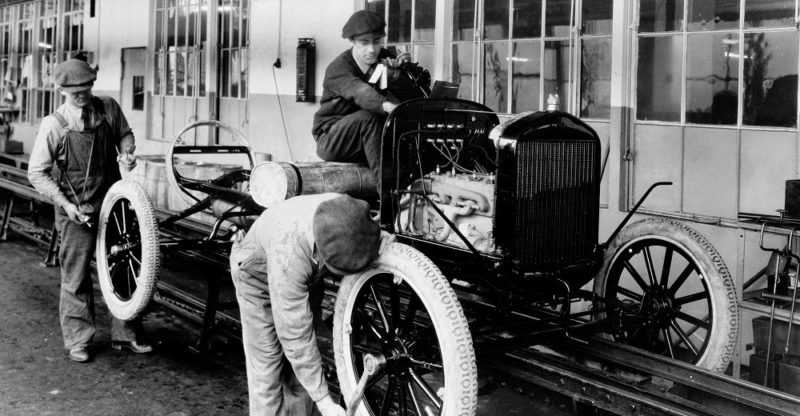
What was the Second Industrial Revolution?
The Second Industrial Revolution was a process of technical innovations and economic transformations that began around 1870 and lasted until the outbreak of World War I, in 1914. It was a period of major economic and social changes that resulted from accelerated technological development.
The technological advances of the Second Industrial Revolution surpassed the innovations in manufacturing of the First Industrial Revolution, transforming everyday life with new sources of energy, new materials for manufacturing and consumption, and new means of communication and transportation.
The Second Industrial Revolution was not limited to Great Britain, but also took place in other Western European countries (particularly in Germany), as well as in the United States and Japan. In this way, capitalism spread at the global level.
- See also: Industrial Revolution
Characteristics of the Second Industrial Revolution
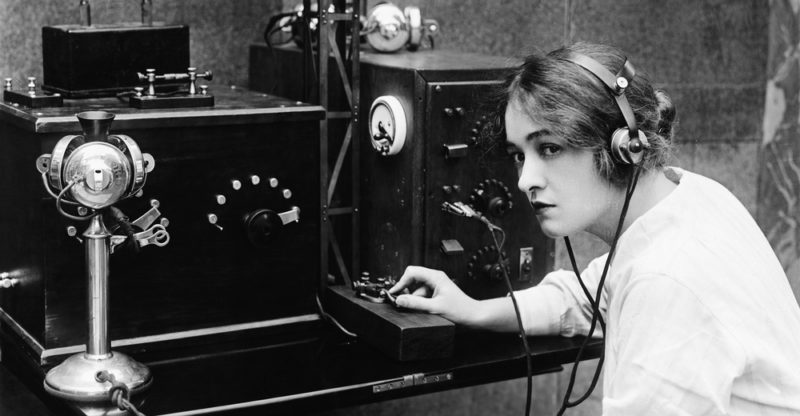
The main characteristics of the Second Industrial Revolution include:
- Geographic spread. Industrialization, which had seen its first phase in Great Britain during the First Industrial Revolution, spread to several countries (particularly Germany, the United States, and Japan).
- Mass production. A new production method called "mass production" or "production line" was introduced, based on the assembly line and a rational division of labor to increase productivity in factories.
- Development of transportation. The rise in steel production for the construction of railways and ships, combined with the use of new fuels and the invention of the automobile and the airplane with internal combustion engines led to unprecedented transportation development.
- New materials and energy sources. Technical and chemical innovations (including petroleum and electricity) entailed the use of new materials and energy sources.
- Telecommunications. A major transformation in telecommunications took place thanks to the invention of the telephone and radio, as well as of other innovations such as the phonograph and the cinematograph.
Inventions of the Second Industrial Revolution
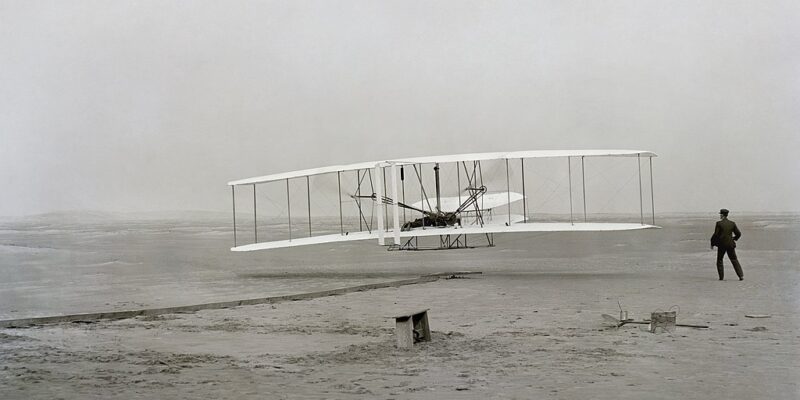
The innovations of the second stage of industrialization brought about profound changes in manufacturing, transportation, communications, and ways of life and leisure. The most important inventions of the Second Industrial Revolution were:
- Internal combustion engine. The exploitation and distillation of petroleum resulted in the origin of gasoline fuel, which began to be used in internal combustion engines that led to the invention of automobiles and airplanes. The first gasoline-powered internal combustion engine was developed by the German Nicolaus Otto in 1876.
- Automobile. The internal combustion engine was first incorporated into an automobile in 1886 by German engineer Karl Benz. The automobile was perfected by the American Henry Ford when he launched his Ford Model T in 1908.
- Airplane. Although aviation was the result of long years of experimentation, it was only in the early 20th century that the development of powered aircraft began, revolutionizing airspace forever. The American Wright brothers were the first to make a sustained flight with a heavier-than-air powered aircraft in 1903.
- Electric tramway. While electric power did not replace steam for the operation of railroads, it led to the invention of a new type of urban passenger transport: the electric tramway. The first electric tramway track opened in Berlin in 1881.
- Telegraph. Although its invention was prior to the Second Industrial Revolution, the use of this device for the transmission of coded messages over long distances by means of electrical signals became widespread during the second half of the 19th century, thanks to the system designed by the American Samuel Morse.
- Radio. The proof of the existence of electromagnetic waves by the German Heinrich Hertz in 1887 led to the invention of the wireless telegraph and the development of the radio by the Italian Guillermo Marconi in the early 20th century.
- Telephone. This telecommunication system was patented by the Scottish Alexander Graham Bell in 1876, its use becoming widespread in the 20th century.
- Phonograph. Invented in 1877 by the American Thomas Alva Edison, it was the first device that made it possible to record and reproduce sound. It was soon surpassed in quality by the gramophone, patented by Emile Berliner in 1887.
- Cinematograph. The first device that allowed filming and screening moving images without sound was invented by the Lumière brothers in France in 1895.
- Electric light bulb. At the start of the Second Industrial Revolution, the exploitation of petroleum made the use of kerosene lamps widespread (kerosene, a liquid obtained from petroleum). However, research in the field of electrical energy spurred experimentation with electric lamps. In 1879, the American Thomas Alva Edison invented a type of carbon-filament incandescent lamp that proved useful for public and domestic lighting.
- Dynamite and TNT. In 1867, Swedish chemist Alfred Nobel patented dynamite, an explosive made from nitroglycerin that was safer than this substance and more powerful than black powder. It began to be used mainly in mining. Another explosive developed during this period was TNT (trinitrotoluene), which was also used in military artillery.
Advances of the Second Industrial Revolution
The mechanization that came about with the First Industrial Revolution deepened with the Second Industrial Revolution. Furthermore, new technological inventions, the use of new energy sources, and new techniques in the organization of work supported the rise of new industries.
Many of these innovations, which benefited from advances in science and chemistry, enabled the development of telecommunications and new means of transportation.
1. Mechanization of work
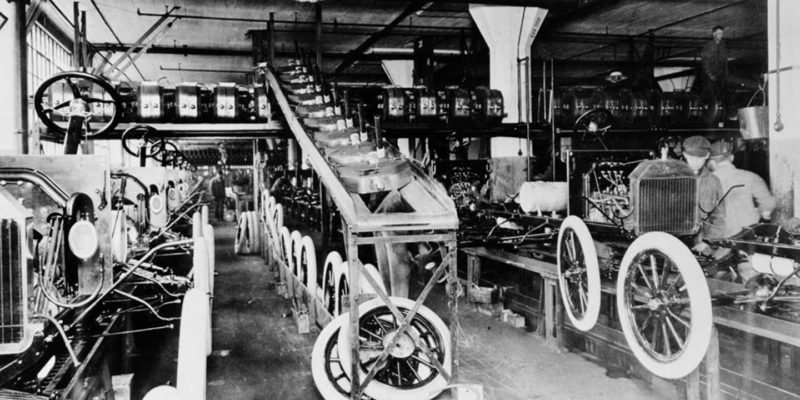
The new production system, introduced during the Second Industrial Revolution to speed up times and reduce costs, was based on the model of the American Frederick Taylor. Known as Taylorism or scientific management, it was a model of mass production in which each worker made a workpiece on an assembly line within a set time (controlled by stopwatches). It was a new form of mechanization of work.
In 1901, businessman Ransom Olds used the assembly line for the first time, and shortly afterwards, the Ford Motors Company adopted the Taylorist system for the production of the Ford Model T, while perfecting the assembly line by incorporating a conveyor belt and increasing workers' wages. Henry Ford's idea was that each worker should earn enough to be able to buy a car, in this way ensuring consumption growth.
This production system came to be known as Fordism, and had major effects: it reduced production costs and multiplied the number of automobiles made and sold. In 1908, eleven Ford T cars had been manufactured in one month, while in 1910 the number reached over 10,000, and in 1914, about 250,000. The assembly time of each car had dropped from twelve and a half hours to 93 minutes, and its price dropped proportionally.
2. Development of transportation
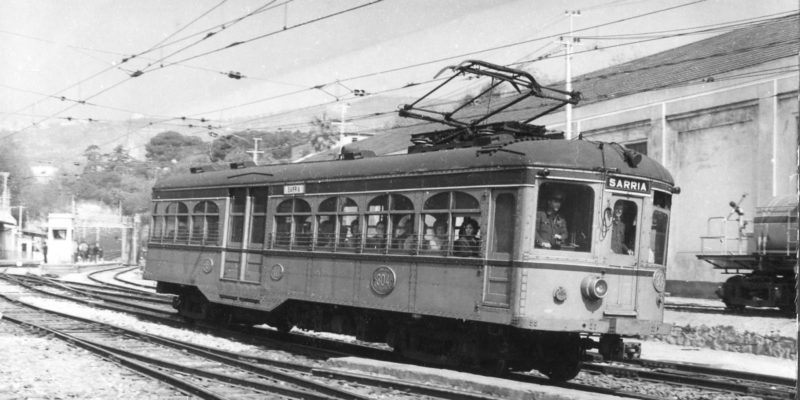
Among the most tangible features of the Second Industrial Revolution was the expansion of railways, which, thanks to the growing use of steel, facilitated the movement of goods and people. England became a leader in the construction of railroads, exporting railroad supplies to other countries. Electricity also stirred the invention of the electric tram for urban passenger transport, with the first track opening in Berlin in 1881.
Ships began to be built of steel, and the steam turbine was invented, allowing ships to be larger, faster, and have lower maintenance costs. Throughout the 20th century, the use of oil in shipping rose.
Moreover, new fuels enabled the development of the internal combustion engine running on gasoline, incorporated for the first time in an automobile by German engineer Karl Benz in 1886, and perfected with the Ford T model designed by the American Henry Ford in 1908. Aviation also developed thanks to the innovations introduced during the Second Industrial Revolution.
3. New sources of energy

Two of the most important innovations of the Second Industrial Revolution were the exploitation and distillation of petroleum and the industrial generation of electricity.
Petroleum
In 1848, Scottish chemist James Young had a small business that refined crude oil. Although records dated from the same period exist in China, it was from this time onwards and with the development of the method for drilling wells in 1859 by the American Edwin Drake that this technique spread worldwide.
Among the fuels derived from petroleum was kerosene, which was used for lighting (it was more efficient and less expensive than vegetable oils). Additionally, it enabled the production of gasoline for internal combustion engines (automobiles and airplanes). The growing importance of oil gave rise in 1870 to Standard Oil, one of the first multinational monopolies.
Electricity
The industrial production of electric power was the other major innovation of the period, the result of studies and experiments carried out by various researchers. In 1879, Thomas Alva Edison invented a type of carbon-filament incandescent lamp, which could be used for both street and domestic lighting.
This method replaced the old kerosene lighting system and transformed life in cities and factories. Electric power also made other innovations possible, including the telephone, radio, and tramway.
4. New materials
Among the new materials or materials whose use became widespread during the Second Industrial Revolution were:
- Steel. Steelmaking from the alloy of iron combined with small amounts of carbon existed prior to the Second Industrial Revolution. However, in 1856 English engineer Henry Bessemer discovered a way to obtain steel in large quantities and at low costs, and in 1865 a group of engineers invented a more controlled method. The introduction of electric furnaces in the late 19th century further perfected steel production, which became widely used in the construction of high-rise buildings, ships, and railways.
- Aluminum. The second half of the 19th century saw advances in the extraction of this metal, especially thanks to the use of electricity, which made production growth possible. Its lightweight and corrosion resistance made it a useful material for vehicles and construction, besides serving as an electrical conductor.
- Zinc. Although zinc was already known, it gained great importance during the Second Industrial Revolution for coating other metals, mainly iron and steel, to protect them from corrosion through a process known as "galvanization".
- Nickel and chromium. While the use of both nickel and chromium was known before the Second Industrial Revolution, it was in the early 20th century that it began to be used to produce stainless steel.
- Vulcanized rubber. Vulcanization was a process developed by the American Charles Goodyear in 1839 for hardening rubber. The use of vulcanized rubber became widespread during the Second Industrial Revolution for conveyor belts, cable insulation, and automobile tires.
- Early plastics. Among early plastic materials was celluloid, developed by the American John Wesley Hyatt in the 1860s and 1870s. In 1907, the Belgian Leo Baekeland invented Bakelite, a thermosetting plastic capable of being molded while hot and hardening upon cooling, considered the first fully synthetic polymer.
5. Telecommunications

Innovations in telecommunications were among the most important of the Second Industrial Revolution
- Telegraph. Invented prior to the Second Industrial Revolution, the telegraph gained popularity thanks to the "Morse code" system developed by American inventor Samuel Morse in 1837. The device made instant communication possible through a language of dots and dashes. It had a great impact in major cities worldwide, where extensive wiring was laid, initially for the use of railroads.
- Radio. Following the discovery of the existence of electromagnetic waves by the German Heinrich Hertz, the Italian Guillermo Marconi applied this knowledge to the development of a wireless telegraph, which gave rise to the radio in the early 20th century.
- Telephone. In 1876, Scottish engineer Alexander Graham Bell patented the telephone in the United States, a telecommunication device designed to transmit conversations through electrical signals. Although there is evidence suggesting that the invention predated Graham Bell's patent, this device gained growing importance throughout the 20th century.
- Cinematograph. In 1895, the Lumière brothers created in France the first cinematograph that transmitted motion pictures without sound. The first film they screened was "Workers Leaving the Lumière Factory". From then onward, the cinema became a highly influential means of expression and communication.
6. Advances in science and chemistry
Scientific research carried out during the Second Industrial Revolution influenced not only manufacturing and communications, but also health and medicine, as it made it possible to control and cure diseases and thus increase life expectancy.
In 1864, chemist Louis Pasteur created a process for food preservation called "pasteurization", through which it became possible to destroy microorganisms and bacteria without altering the original composition. His studies in microbiology also influenced the development of vaccines and antibiotics.
In 1882, physician and microbiologist Robert Koch discovered the bacterium that causes tuberculosis. In 1897, chemist Felix Hoffmann synthesized acetylsalicylic acid which, two years later, was patented by Bayer company under the name Aspirin.
Experiments and research in chemistry spurred the development of fertilizers for agriculture, as well as explosives for the mining industry and military activity, used mainly during World War I. Research carried out during this period eventually led to further development of nuclear weapons such as those used during World War II.
Causes of the Second Industrial Revolution
The main causes of the Second Industrial Revolution were the spread of industrialization beyond Great Britain (where it had begun), the invention of new techniques and technologies, the emergence of industrial entrepreneurship, and the rise of a modern financial system.
Other factors that contributed to this process were the political role of the bourgeoisie, the availability of raw materials both local and from the colonies, and the growth of the urban population (which increased the demand for goods and services).
- Industrial expansion and new inventions. The technical and technological innovations of the First Industrial Revolution spread to other countries and regions, in particular to the United States, Western Europe and Japan, leading, in turn, to new research and inventions.
- Emergence of modern entrepreneurs and modern banks. Wealth accumulation, interest in profit-making, and the development of economic management by industrial entrepreneurs, combined with the expansion of international trade and the financial system, supported capital investment.
- Political rise of the bourgeoisie. Political changes in Europe such as the Third Republic in France (1870) and the unification of Germany (1871) allowed the rise of the industrial bourgeoisie and economic modernization. In Germany, the industry was strongly stimulated through protectionist policies.
- Availability of raw materials. Access to raw materials, both local (for example, cotton and oil in the United States, or iron and coal in Germany) and from the colonies (for example, Indian cotton exported to England), was vital to the supply of industrial production. At the same time, the Second Industrial Revolution promoted an imperialist race among the European powers to obtain raw materials in Africa and Asia.
- Population growth and increased demand. The growth of the urban population to unprecedented levels led to a rise in the demand for goods and services in cities, which resulted in increased industrial production.
Effects of the Second Industrial Revolution
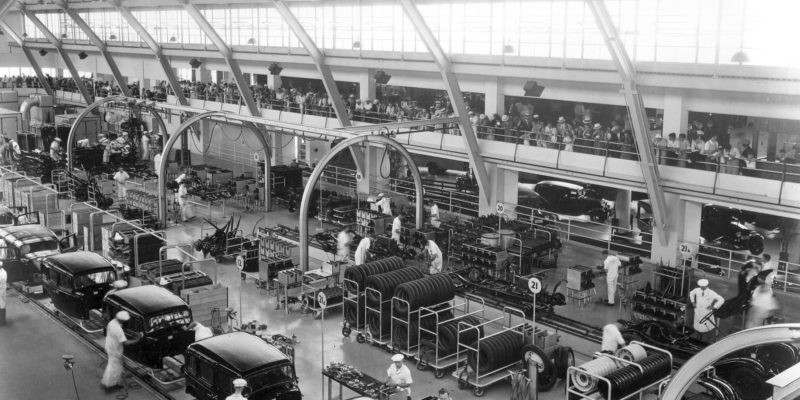
The main effects of the Second Industrial Revolution were increased productivity, growing unemployment, the expansion and modernization of cities, mass consumption, continuous development of technological innovations, the organization of the labor movement, the global expansion of capitalism, and the military use of new technologies.
- Increased productivity. The standardization of manufacturing that took place during the Second Industrial Revolution led to accelerated production time, increasing the productivity of large companies.
- Growing unemployment. The replacement of employees with machinery caused unemployment during the Second Industrial Revolution.
- Expansion and modernization of cities. Urban sprawl meant a bigger number of major cities, which became even more populated and modern through the use of electricity for lighting, transportation (electric tram), and communications (telephone); the construction of large engineering works (such as wrought iron or steel bridges); and in cities like New York or Chicago, skyscrapers (made possible thanks to the steel industry, reinforced concrete, and the invention of the elevator).
- Mass consumption. The use of new technology fueled mass consumption, both of consumer goods and entertainment (including cinema and radio), and sparked further innovations that transformed everyday life throughout the 20th century.
- Development of technological innovations. New techniques and technologies laid the groundwork for constant innovations that continued to change production and consumption throughout the 20th century, such as the refinement and increased speed of the means of transportation.
- Strengthening of the labor movement. Socialist and anarchist unions motivated the creation of the labor movement, which sought to cope with rising unemployment and the growing exploitation of labor, and aimed to improve the living standards of workers and demand a better distribution of wealth. In some cases, these demands went hand in hand with attaining political power or transforming the social order.
- Global expansion of capitalism. The Second Industrial Revolution encouraged the expansion of capitalism worldwide, which benefited manufacturing countries. Moreover, capitalism was closely linked to imperialism which, among other things, prompted the partition of Africa among the great European powers.
- Military use of new technologies. When World War I broke out in 1914, the technological advances that were brought about by the Second Industrial Revolution shaped a new type of conflict, much more lethal than previous ones due to the use of new technologies.
Differences between the First and Second Industrial Revolution
Although the Second Industrial Revolution was largely an acceleration of the changes brought about by the First Industrial Revolution, the two processes had some important differences.
The First Industrial Revolution marked the emergence of large-scale mechanized work and factories, the transformation of transportation, and the rise of major industrial cities in England.
In turn, during the Second Industrial Revolution industrialization spread to other countries, the pace of technological innovations accelerated, production techniques were refined, new materials and energy sources were introduced, new means of transportation and communication were invented, and cities grew dramatically.
The main differences between the two periods are shown in the comparison chart below:
| Aspect | First Industrial Revolution | Second Industrial Revolution |
|---|---|---|
| Geographic location | England | Germany, the United States, Japan, France, Belgium, and England |
| Technological innovations | Steam engine, textile machinery, gas lighting | Internal combustion engine, electricity, chemical industry, telecommunications (telephone, radio) |
| Energy sources | Coal | Coal, petroleum, electricity |
| Major industries | Textile industry, mining, iron working, transportation (railroads and steamships) | Steel industry, chemical industry, electric power industry, telecommunications (telephone, radio), transportation (automobiles, airplanes, electric trams, ships made of steel) |
| Major technological innovation | Mechanization of factory work | Mass production, assembly line, use of electricity in factories |
Third Industrial Revolution
A third period of changes known as the Third Industrial Revolution or Digital Revolution took place in the 1970s and 1980s.
Its main feature was the rise of digital and computer technology. In manufacturing, innovation led to industrial automation (i.e. the development of automated machines capable of performing all kinds of tasks, including making parts for other machines).
The spread of information technology marked a turning point in communications and services. In the 1970s, the manufacture of personal or home computers began, available in the most industrialized countries such as the United States and Japan. Likewise, the first cellular phones were made.
During the 1990s, the use of computers expanded, giving rise to the World Wide Web age, and popularizing the use of the Internet. The age initiated with the Third Industrial Revolution is often referred to as the "information age". Other innovations of the Third Industrial Revolution include biotechnology (techniques for manipulating living substances for food or pharmaceutical production), and energy engineering (the search and development of new energy sources).
Explore next:
- Causes and effects of the Industrial Revolution
- Third Industrial Revolution
- Fourth Industrial Revolution
References
- Britannica, Encyclopaedia (2022). Industrial Revolution. Encyclopedia Britannica. https://www.britannica.com
- Coriat, B. (1982). El taller y el cronómetro. Ensayo sobre el taylorismo, el fordismo y la producción en masa. Siglo XXI.
- Hunt, L., Martin, T. R., Rosenwein, B. H. & Smith, B. G. (2016). The Making of the West: Peoples and Cultures. 5a edición. Bedford/St. Martin’s.
- Mokyr, J. (1999). The Second Industrial Revolution, 1870-1914. Storia dell’economia Mondiale. https://en-econ.tau.ac.il
Was this information useful to you?
Yes NoThank you for visiting us :)